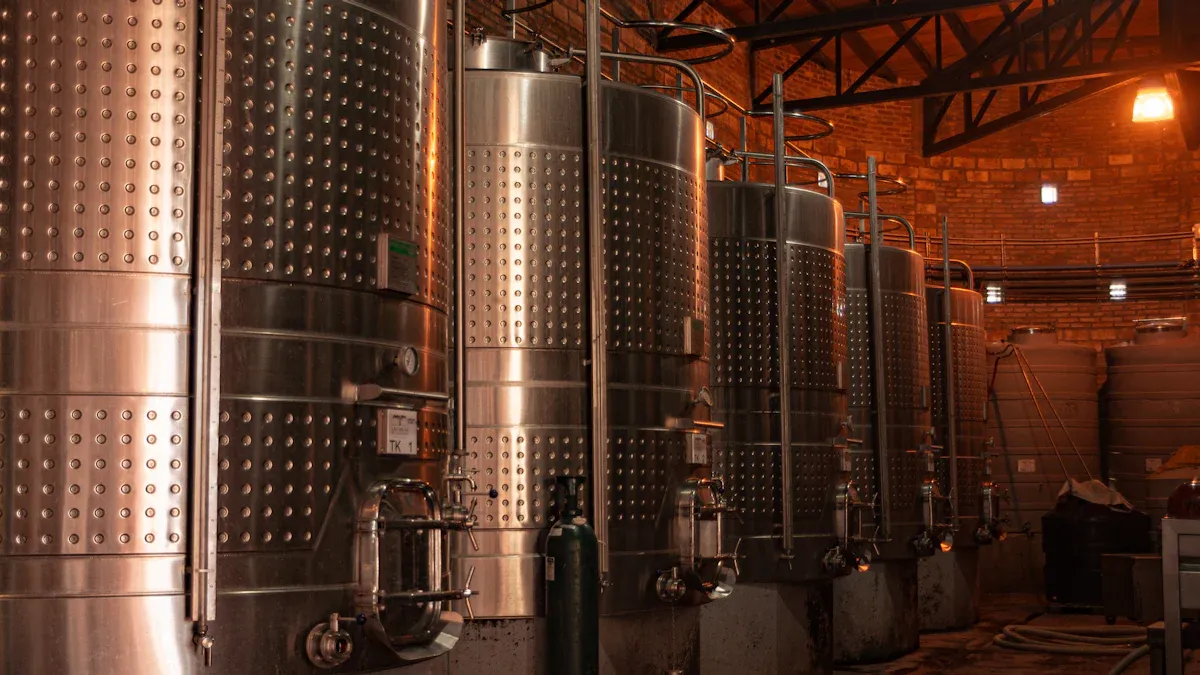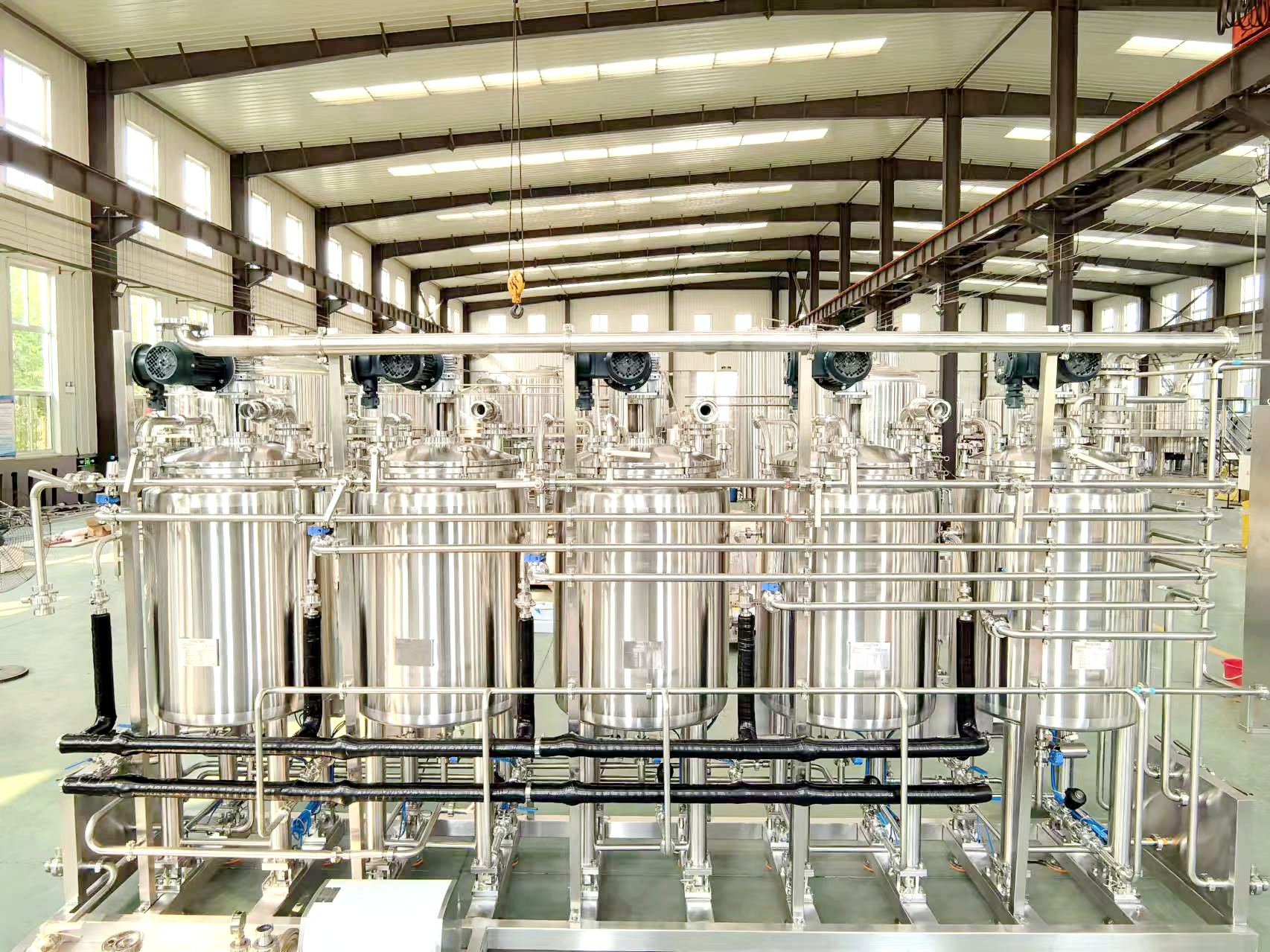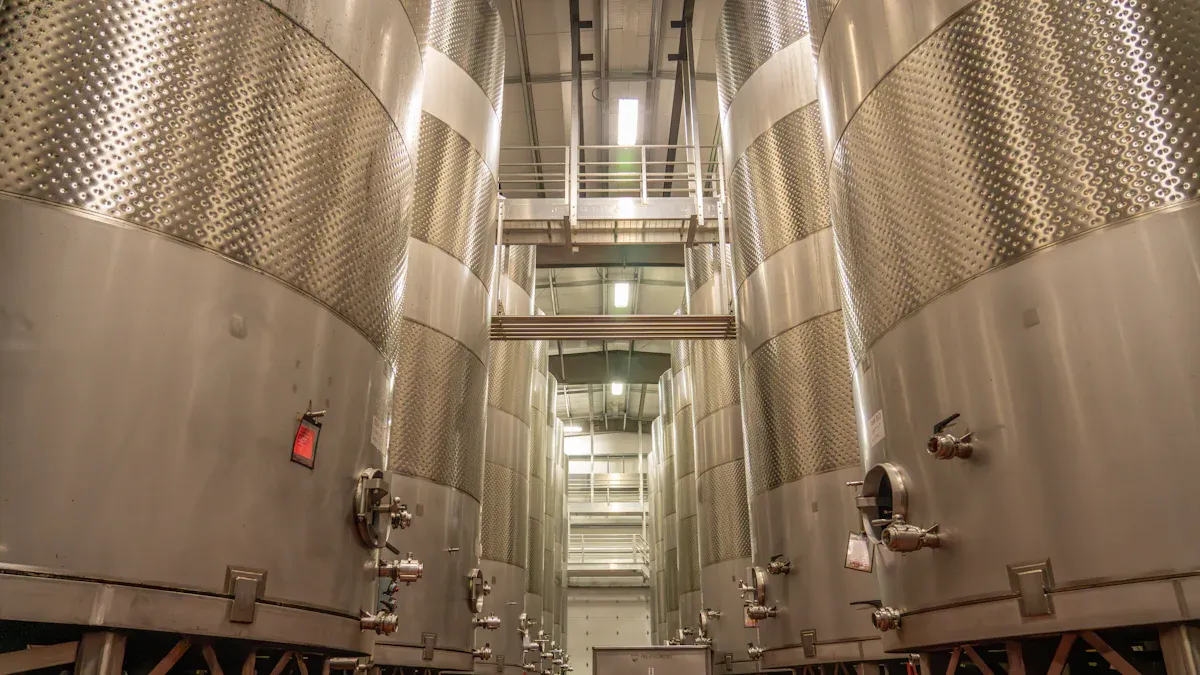
Can you ferment wine in stainless steel? Absolutely! You might notice more wineries using these tanks now than ever before. Stainless steel tanks have taken over the wine industry in the past decade because they last a long time, resist corrosion, and stay easy to clean. These tanks help you keep your wine pure, letting you control temperature and preserve flavor. Just remember, initial cleaning is key to making sure your setup stays spotless and your wine tastes great.
Key Takeaways
- Stainless steel tanks are durable and easy to clean, making them a top choice for winemaking.
- These tanks preserve the true flavors of grapes, allowing for fresh and vibrant wines without added flavors.
- Proper cleaning and maintenance are essential to prevent bacteria and ensure great-tasting wine.
- Smart features in modern tanks, like temperature control and remote monitoring, enhance the winemaking process.
- Choosing the right tank size and setup can improve efficiency and support your winemaking goals.
Can You Ferment Wine in Stainless Steel
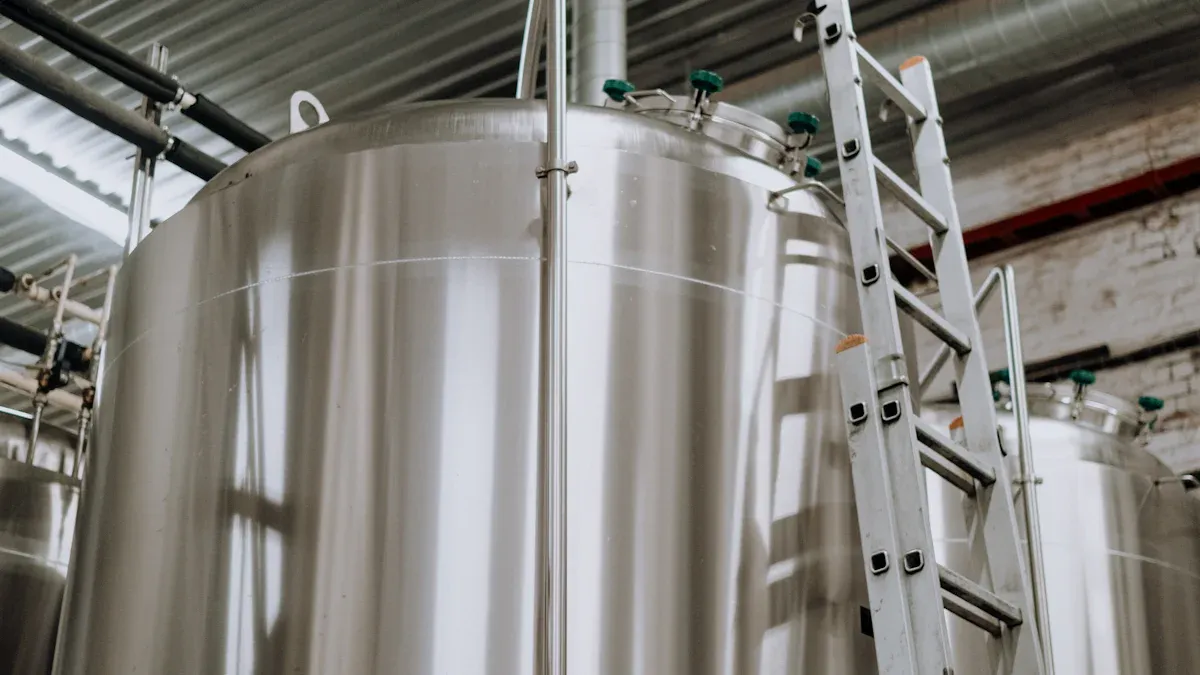
Why Stainless Steel Is a Top Choice for Winemaking
You might wonder, can you ferment wine in stainless steel and still get great results? The answer is yes, and many winemakers choose this method for good reasons. Stainless steel tanks do not add any extra flavors to your wine. This means you taste the true character of the grapes. If you want your wine to be fresh and fruit-forward, stainless steel is the best choice.
Here’s a quick look at how stainless steel compares to other materials:
| Criteria | Stainless Steel Tanks | Oak Barrels |
|---|---|---|
| Influence of oxygen | Very low | Slow introduction |
| Taste/flavor | Crisp, vibrant, fruity | Vanilla, caramel, spice |
Stainless steel tanks also keep your wine safe from unwanted bacteria. Their smooth surface makes cleaning easy, which is important for both large wineries and homebrewing fans. You can rely on stainless steel to keep your wine pure and consistent.
Main Advantages of Stainless Steel Fermentation
So, can you ferment wine in stainless steel and get all the benefits? Absolutely! Here are some of the main advantages you’ll notice:
- Stainless steel tanks last for decades. They resist rust and do not absorb odors or flavors.
- You get precise temperature control. Many tanks come with cooling or heating jackets, so you can manage fermentation easily.
- Cleaning is simple. The smooth surface means less chance for bacteria to grow.
- Stainless steel does not react with wine. Your wine keeps its natural flavors.
- These tanks meet strict food safety standards, so you know your wine is safe.
Tip: If you want to make a wine that truly shows off your grapes, stainless steel is the way to go. You get a clean, crisp taste every time.
Let’s look at some chemical and hygiene benefits:
| Benefit Type | Description |
|---|---|
| Chemical Stability | Stainless steel does not react with wine, so flavors stay true. |
| Hygiene | Easy to clean, which keeps bacteria away. |
| Microbial Contamination | Less risk of spoilage because you can sanitize the tank thoroughly. |
You can see why so many winemakers, from big companies to homebrewing enthusiasts, trust stainless steel.
Potential Drawbacks to Consider
Now, can you ferment wine in stainless steel and avoid all problems? While stainless steel tanks offer many benefits, you should know about a few possible drawbacks:
- The initial cost is higher than some other materials. You pay more upfront, but the tank lasts much longer.
- Stainless steel does not add flavors like oak barrels do. If you want those vanilla or caramel notes, you might need to age your wine in oak after fermentation.
- Installing a large tank can be tricky and may need special equipment or help.
- Stainless steel does not let oxygen in. Some winemakers use micro-oxygenation to add a small amount of oxygen, which can help soften the wine.
Note: Most of these drawbacks are easy to manage if you plan ahead. For most people, the benefits of stainless steel far outweigh the challenges.
Can you ferment wine in stainless steel and get a wine that tastes just how you want? Yes, you can. With the right setup and a little know-how, your wine will shine.
Essential Steps for Setting Up Stainless Steel Fermentation Tanks
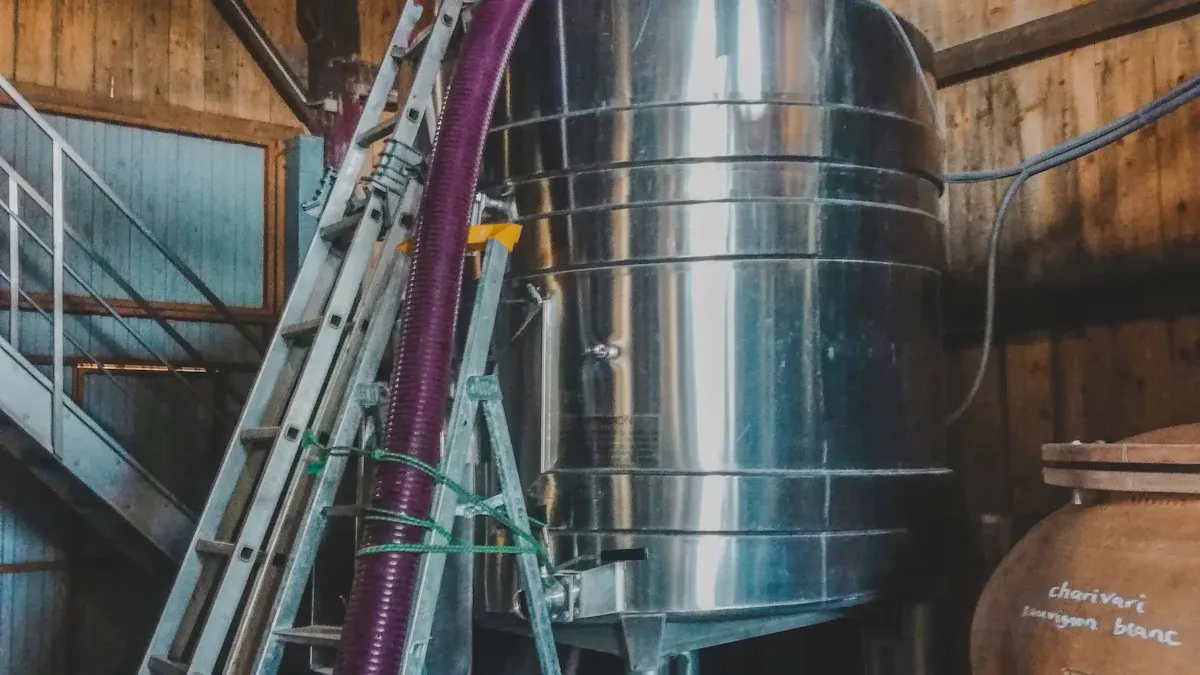
Choosing the Right Tank Size for Your Needs
Picking the right tank size makes a big difference in your winemaking process. You want a tank that matches your production volume, so you don’t waste space or end up with too little room. Here are some things you should think about:
- Check your production volume. Make sure your tank fits your output and doesn’t leave too much unused space.
- Look for high-quality stainless steel, like AISI 304 or AISI 316. These materials last longer and resist corrosion.
- Plan for growth. If you expect your winery to expand, choose a tank with extra capacity.
If you keep these points in mind, you’ll set up your fermentation vessels for success.
Variable Capacity vs. Fixed Volume Stainless Steel Tanks
You have two main choices for tanks: variable capacity and fixed volume. Each type has its own pros and cons. Take a look at this table to see how they compare:
| Pros of Variable Capacity Tanks | Cons of Variable Capacity Tanks |
|---|---|
| Adjust the tank size for each batch | Check the floating lid and gasket often for leaks |
| Protect wine from oxidation with an airtight floating lid | Clean the lid and gasket carefully to avoid contamination |
| Control temperature for better fermentation | May not suit very large batch production as well as fixed tanks |
| Save space by using fewer tanks | N/A |
| Try new blends or small batches easily | N/A |
Variable capacity tanks give you flexibility. You can make small or large batches and experiment with new blends. These tanks help prevent oxidation because the floating lid adjusts to the wine level. Fixed volume tanks work better for big batches and steady production. Some winemakers also use conical fermenters for easy cleaning and efficient fermentation.
Must-Have Components for Stainless Steel Fermenters (Including SDCHENMA)
To get the best results, your tank needs certain features. Here’s what you should look for:
- Temperature control keeps your wine at the right level for fermentation.
- pH regulation helps microorganisms do their job.
- Oxygen control is important for yeast growth.
- Nutrient supply supports healthy fermentation.
SDCHENMA tanks offer extra benefits. You get customizable designs that fit your needs. Precise temperature control keeps flavors balanced. Effective oxygen management reduces oxidation and preserves aroma. Smooth surfaces make cleaning easy and keep bacteria away. Floating lids and dimple cooling jackets help maintain ideal conditions. RTD probes and gas-tight seals let you monitor and protect your wine.
Tip: Choose a tank with these features to make your winemaking easier and your wine better.
Placement and Installation Tips for Stainless Steel Tanks
Setting up your stainless steel tank the right way makes your winemaking process smoother and safer. You want to start by looking at your space. Measure your winery’s floor area and ceiling height. This helps you pick a tank that fits without crowding your workspace. If your space is tight, portable tanks work well. Bigger wineries can use larger tanks for more wine.
Think about where you will put your tank. Here are some important tips:
- Pick a flat, stable spot that can hold the full weight of your tank.
- Make sure you have enough room around the tank for cleaning and repairs.
- Leave space between the tank and walls or other equipment.
- Choose a base like a concrete slab or compacted gravel. This keeps your tank steady and dry.
- Plan for good drainage. Water should not pool around your tank.
Environmental factors matter, too. Humidity and rain can cause rust if your tank sits outside. If you live near the ocean, salt in the air can speed up corrosion. Soil with lots of clay or acid can also wear down your tank faster. You may need extra protection in these places.
When you install your tank, follow these steps:
- Check that the tank size matches your yearly wine production.
- Make sure your tank has temperature control features, like cooling jackets.
- Decide if you want an open-top tank for red wines or a closed-top tank for white wines.
- Place your tank where you can reach it easily for filling, emptying, and cleaning.
- Double-check that your base is level and strong.
Tip: Careful planning now saves you time and trouble later. A well-placed tank keeps your workflow smooth and your wine safe.
DIY Stainless Steel Fermenters: Customization and Modifications
Common DIY Upgrades and Modifications
You can make your diy stainless steel fermenters work even better with a few simple upgrades. Many home winemakers love to add their own touches. Here are some popular ways to customize your setup:
- Drill a 1 1/4″ hole in the lid for a better airlock. This helps you control gases during fermentation.
- Use silicone tubing around the kettle lip. This creates a tight seal and keeps air out.
- Add a ball valve near the bottom. You can transfer wine easily without lifting the tank.
- Install a thermowell. This lets you check the temperature inside the tank without opening it.
Some winemakers also try out conical fermenters. These tanks have a cone-shaped bottom, which makes it easy to collect yeast and clean up after fermentation.
Tip: Start with small changes. You can always add more upgrades as you learn what works best for your wine.
Safety Tips for DIY Stainless Steel Fermenters
Safety should always come first when you work on your fermenters. Here are some important tips to keep you safe:
- Wear protective eyewear and gloves when you use strong cleaners or acids.
- Make sure your tank sits on a flat, stable surface. This keeps it from tipping over, especially when it is full of hot liquid.
- If you use any electrical parts, keep them dry and use grounded outlets.
- Check for gas leaks if you use burners or gas lines. Always watch for safe burning to avoid carbon monoxide.
- Let CO2 escape from your fermenter. Use a pressure relief valve and never seal a hot vessel.
Note: Taking a few extra minutes for safety can save you from accidents and keep your wine safe, too.
Key Setup Considerations for Stainless Steel Tanks in 2025
New Technologies and Smart Features in Stainless Steel Fermentation
You will see a lot of new technology in stainless steel wine tanks in 2025. These upgrades make your winemaking easier and more precise. Many tanks now come with automated control systems. These systems use sensors to watch and adjust fermentation in real time. You can check your tank from your phone or computer. Smart sensors and IoT devices help you track temperature, pH, and sugar levels. Some tanks even use E-nose and E-tongue tech to monitor gases and flavors. This means you can catch problems early and keep your wine on track.
Here’s a quick look at the latest advancements:
| Advancement Type | Description |
|---|---|
| Automated Control Systems | Sensors monitor and adjust fermentation for steady quality. |
| Smart Sensors and IoT Integration | Real-time data and remote monitoring help you react fast. |
| Advanced Materials | New alloys and polymers boost durability and insulation. |
| Energy-Efficient Systems | Better heat recovery and insulation save energy and money. |
| Modularity and Scalability | Tanks fit into any setup and grow with your needs. |
Smart features like real-time data logging and cloud analytics help you make better decisions. You can focus on the fun parts of winemaking, whether you run a big winery or enjoy homebrewing.
Updated Safety Standards for 2025
Safety matters more than ever. In 2025, you need to follow strict rules for your stainless steel tank. These rules keep your wine safe and your equipment reliable. You should check that your tank meets ASME and API standards. These standards make sure your tank can handle the chemicals and temperatures in winemaking. Material tests confirm the steel is strong and pure. Pressure tests, like hydrostatic testing, show your tank can handle stress. The ASME Code covers design, building, and testing. Following these rules helps you avoid risks and keeps your tank working well.
Sustainability and Eco-Friendly Practices in Stainless Steel Tank Setup
You can help the planet by choosing eco-friendly options for your tank setup. Stainless steel tanks last a long time and resist rust, so you do not need to replace them often. This saves energy and cuts down on waste. When your tank reaches the end of its life, you can recycle it. This keeps metal out of landfills and saves resources. New production methods use less energy, which lowers the carbon footprint. Stainless steel tanks also keep water hot or cold longer, so you use less energy for heating or cooling. If you use conical fermenters, you will find they are easy to clean and maintain, which also saves water and energy.
Tip: Choosing a sustainable tank setup helps your winery and the environment.
Practical Tips for Successful Stainless Steel Wine Fermentation
Cleaning and Maintenance Best Practices
Keeping your stainless steel tank spotless is the secret to great wine. You want to start every batch with a thorough initial cleaning. This step removes any dust or residue left from storage. After each use, repeat the initial cleaning to keep your tank in top shape.
Here’s a simple cleaning routine you can follow:
- Rinse the tank with cold, high-pressure water.
- Wash with a strong alkaline solution to break down any leftover wine or food waste.
- Rinse again with cold water.
- Sanitize using hot water (about 180ºF) or steam.
- Rinse off any sanitizer with fresh cold water.
- Finish with a hot water rinse, ideally heat-sterilized.
- For extra protection, you can treat the tank with ozone.
You should always clean the fermenter before and after each use. Avoid using abrasive scrubbers because they can scratch the surface. Scratches can trap bacteria and make cleaning harder. Inspect your tank for dents or scratches and store it in a cool, dry place away from sunlight. Passivation is also important. This chemical process restores the protective layer on your tank, helping prevent rust and keeping your equipment strong for years.
Regular maintenance and cleaning stop bacteria from building up and help your tank last longer. You save time and money by preventing problems before they start.
Monitoring and Temperature Control
You need to keep a close eye on your wine during fermentation. Temperature control is key. If the tank gets too hot or too cold, your wine might not taste right. Many modern tanks come with built-in temperature controls, but you can also use a thermometer to check the temperature yourself.
Try to keep the fermentation temperature steady. If you’re into homebrewing, you might use a simple thermometer or a digital sensor. For larger setups, automated systems can help you monitor and adjust the temperature. Monitoring pH and sugar levels also helps you catch any issues early. This way, you keep your wine on track and avoid surprises.
Tip: Clean in place systems make it easier to keep your tank clean without moving it. This saves effort and keeps your wine safe.
Troubleshooting Common Issues
Sometimes, things don’t go as planned. If you notice odd smells or slow fermentation, check your tank for leftover residue from the last batch. Skipping initial cleaning can cause these problems. If you see leaks or dents, fix them right away to avoid bigger issues. Watch for changes in temperature or pH, as these can signal trouble.
Here are a few quick fixes:
- If fermentation slows down, check the temperature and adjust if needed.
- If you spot a leak, tighten fittings or replace seals.
- If you find residue, repeat the cleaning steps before starting a new batch.
Staying alert and acting fast helps you keep your wine tasting great every time.
Stainless steel tanks give you a smart, reliable way to ferment wine in 2025. You get long-lasting equipment that’s easy to clean and helps you save money. Take a look at what industry experts say:
| Key Points | Description |
|---|---|
| Sustainability | Stainless steel is one of the most recycled materials. |
| Durability | Tanks last for years and work for many wine styles. |
| Cost Efficiency | Cleaning and upkeep are simple, lowering your expenses. |
- Using recycled materials cuts down on waste and costs.
- Energy-saving designs help the planet and your wallet.
Start with trusted tanks like SDCHENMA, keep up with new tech, and always follow good cleaning habits. You’ll set yourself up for success in every batch.
FAQ
Can you ferment both red and white wine in stainless steel tanks?
Yes, you can ferment both red and white wine in stainless steel tanks. These tanks keep flavors pure and let you control temperature. Many winemakers use them for all types of wine.
How often should you clean your stainless steel fermenter?
You should clean your tank before and after every batch. This keeps your wine safe and tasting great. Always rinse, wash, and sanitize for the best results.
Do stainless steel tanks affect the taste of wine?
No, stainless steel tanks do not add any flavors to your wine. You taste only the grapes. If you want oak flavors, you can age your wine in barrels after fermentation.
What smart features can you find in new stainless steel tanks?
Many new tanks have digital temperature controls, sensors, and remote monitoring. You can track fermentation from your phone or computer. These features help you make better wine with less guesswork.

